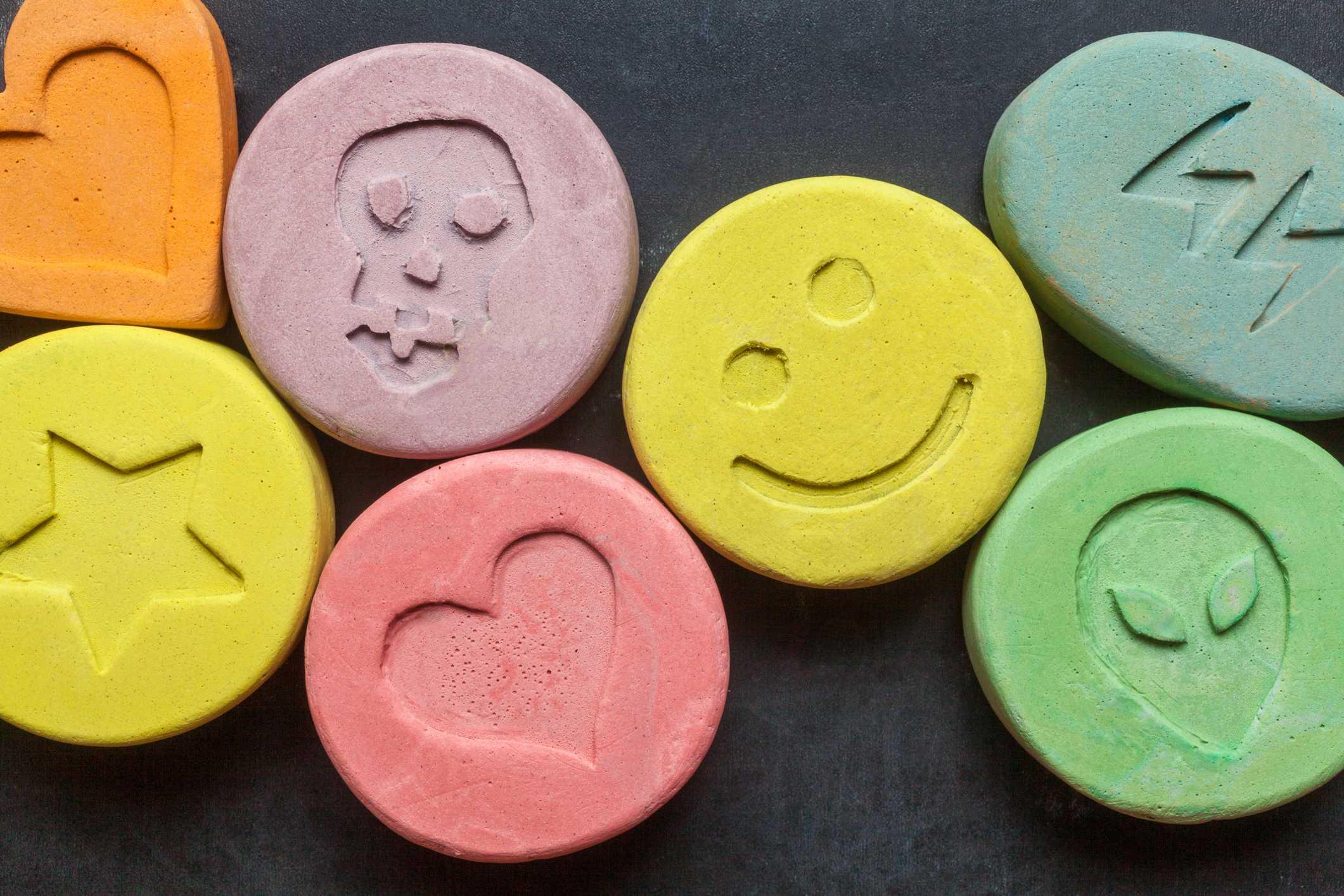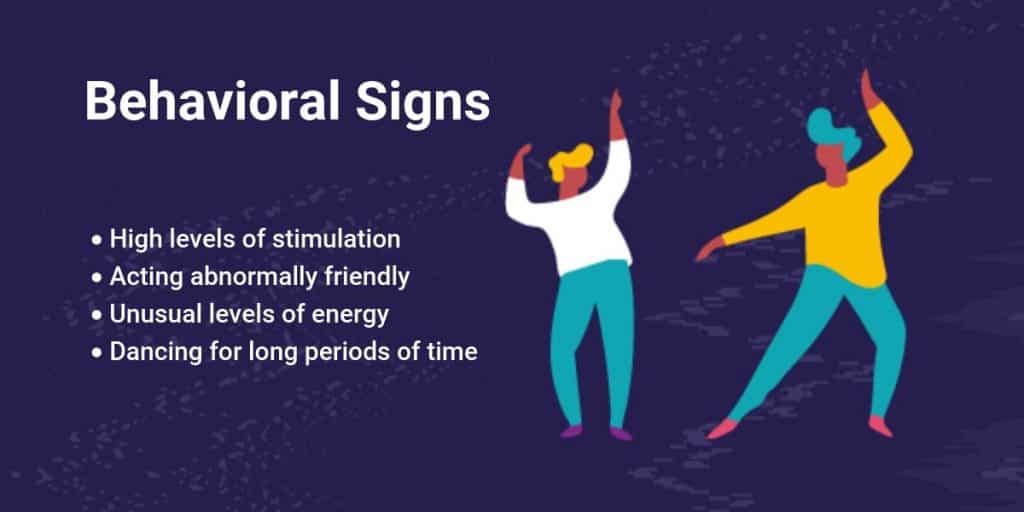Ecstasy is the street name commonly used to refer to a synthetic drug known scientifically as MDMA—short for 3,4-methylenedioxy-methamphetamine. It’s classified as an illegal psychoactive substance that functions primarily as a stimulant but is also known for its mild hallucinogenic effects. While the terms “ecstasy” and “molly” are sometimes used interchangeably, they don't always mean the same thing. Both refer to MDMA, but the difference lies in the form: ecstasy typically comes in colorful pills or pressed tablets, often decorated with logos or symbols, while molly usually refers to a supposedly purer form of MDMA, usually in the form of a white powder or crystalline substance.
However, the lines between the two can get very blurry in the real world. What’s labeled as molly isn’t always pure MDMA, and pills sold as ecstasy can include an unpredictable cocktail of other drugs and chemicals—making the experience not only unreliable but sometimes extremely dangerous.
Where Did Ecstasy Come From? A Quick History
Ecstasy wasn’t born in the rave scene. It actually dates back to the early 20th century. The drug was first synthesized in 1912 by the pharmaceutical company Merck. At the time, it was not developed as a recreational substance but as a potential aid in medical research.
Fast forward to 1953, and MDMA found a new purpose—this time, in military testing. The U.S. Army experimented with MDMA as part of psychological warfare assessments, though little came of it at the time. By the 1960s, some psychotherapists began to explore the compound for therapeutic use. They believed MDMA could help patients break down emotional barriers and become more open during counseling sessions, thanks to its ability to reduce inhibitions.
It wasn’t until the mid-1970s that the drug made its way into recreational use. Partygoers began using it to enhance feelings of euphoria and connection. From underground therapy offices to the dance floors of discos and clubs, MDMA took on a new identity: the “love drug.”
The Rise and Risk of Ecstasy in the 1980s
By the early 1980s, MDMA was being widely marketed as a party enhancer. It was promoted as “the hottest thing in the ongoing search for happiness through chemistry,” becoming a staple at nightclubs and weekend events. During this brief window, MDMA was still legal and sold under the brand name “Ecstasy.” But this honeymoon period didn’t last long. By 1985, concerns about safety, brain damage, and abuse potential led to a federal ban on the substance in the United States.
Once made illegal, ecstasy went underground—and with that came a shift in its production and contents. No longer regulated, what drug dealers began calling “ecstasy” often bore little resemblance to the original MDMA compound. Pills sold under the name could contain just a small amount—or none—of MDMA. Instead, they were often laced with a cocktail of other dangerous substances such as:
-
LSD
-
Cocaine
-
Heroin
-
Amphetamines
-
Methamphetamine
-
Synthetic cathinones ("bath salts")
-
Animal medications (like dog dewormer)
-
Caffeine
-
And even toxins like rat poison
Even though many of these pills were imprinted with fun symbols like smiley faces or cartoon characters to look appealing, the content inside could be unpredictable or even deadly. The greatest danger? Users had no real idea what they were taking—or what combinations they might have already consumed.
That’s where the risk grows exponentially. People often chase a previous high by increasing their dosage, unaware they’re taking a different blend of chemicals each time. This unpredictability makes ecstasy far more dangerous today than many realize.
How Is Ecstasy Taken?
The most common form of ecstasy is still the pill or tablet, but it's not the only way the drug is used. Some people crush and snort it. Others dissolve it into liquid or attempt to inject it. But a word of caution—what’s sometimes called “liquid ecstasy” is often not MDMA at all. In most cases, “liquid ecstasy” refers to GHB (gamma-hydroxybutyrate), a completely different substance that works as a depressant on the central nervous system.
And GHB has its own terrifying backstory. It’s the same chemical sometimes found in industrial cleaning agents like floor strippers and drain cleaners. Despite this, it’s still misused recreationally, often in club settings.
This confusion between substances only adds another layer of danger, especially when users unknowingly combine different drugs or don’t fully understand what they’re putting in their bodies.

How Ecstasy Affects You in the Short Term
The impact of ecstasy isn’t the same for everyone. The way MDMA affects your body and mind depends on a combination of factors—your body size, weight, metabolism, general health, prior experience with the drug, and whether you’re taking anything else at the same time (including alcohol or medications). Even your mood and environment can influence how intense or enjoyable—or how dangerous—the experience becomes.
It’s important to remember this: no level of drug use is entirely safe. Even over-the-counter medications carry risks. But with substances like ecstasy, which are often cut with unknown chemicals, the risks escalate significantly. Every dose is a gamble.
Short-Term Effects After Taking Ecstasy
Once ingested, ecstasy usually starts to take effect anywhere between 20 minutes and an hour. The effects can last for around 4 to 6 hours—though some people report after-effects lingering much longer.
Mild to Moderate Dosages
Here are some of the effects that may appear after taking a standard dose of ecstasy:
-
An elevated sense of confidence and sociability
-
Boost in energy and alertness
-
A temporary collapse of social inhibitions
-
Warm, positive emotions or a sense of inner peace
-
Heightened emotional sensitivity or empathy toward others
-
Intense feelings of connection—often romantic or communal in nature
-
Unusual sensory perception: colors might seem brighter, music may sound deeper
-
Tingling sensations on the skin
-
Dilated pupils and increased visual sensitivity
-
Sweating due to increased body temperature
-
Tight jaw muscles leading to clenching or grinding teeth
-
Nausea or queasiness
-
Dry mouth and loss of appetite
-
Uncoordinated or shaky muscle control
-
Muscle soreness or stiffness
-
Spikes in heart rate and blood pressure
-
Feelings of anxiety or restlessness
-
Episodes of paranoia, mood swings, or in rare cases, psychotic behavior
While the euphoric effects are what draw users in, it’s easy to overlook how quickly the experience can turn unpleasant—or even dangerous.
High Dosage and Overdose Risks
When a person takes a large dose of ecstasy—or redoses repeatedly over a short period—the risk of overdose climbs significantly. At these levels, the body and brain can be pushed far beyond their limits. Effects of a high dose may include:
-
Intense floating or “out-of-body” sensations
-
Vomiting and gastrointestinal distress
-
Critically high body temperature (hyperthermia)
-
Rapid, dangerous spikes in blood pressure
-
Racing heartbeat or irregular rhythms
-
Hallucinations, confusion, or distorted reality
-
Unpredictable and often dangerous behavior
-
Seizures or convulsions
Ecstasy has been directly linked to several deaths, typically due to cardiovascular failure (like heart attacks) or catastrophic neurological events (such as brain hemorrhages). Sometimes, the problem is dehydration or overheating—particularly during vigorous dancing in hot environments—combined with the drug’s effects on body temperature regulation.
Dealing With the Aftermath: The “Come Down” Phase
Once the initial euphoria fades, users often experience what’s known as a "comedown"—a kind of emotional and physical crash that can linger for days. The intensity of the comedown often mirrors the dose taken, the presence of other substances, and whether the user is already sleep-deprived or under stress.
Common symptoms during the comedown include:
-
Profound exhaustion or fatigue
-
Depressed mood and irritability
-
Restlessness and trouble sleeping
-
Feelings of nervousness or anxiety
-
Difficulty focusing or thinking clearly
-
Paranoid thoughts or emotional withdrawal
In some cases, users feel emotionally raw or mentally “flat,” like their emotions are numbed or blunted. This can lead some to attempt to counteract the crash with other substances—alcohol, cannabis, sedatives, or even more ecstasy—setting up a dangerous pattern of dependency or poly-drug use.
Long-Term Impact: What Prolonged Ecstasy Use Can Do
While occasional use already carries risks, habitual or heavy use of ecstasy over time introduces even more serious long-term consequences. Research has shown that regular MDMA use can affect specific regions of the brain—particularly those involved in mood regulation, memory, and decision-making. This is largely due to how ecstasy interacts with serotonin, a key neurotransmitter.
Long-term users may experience:
-
Persistent low moods or clinical depression
-
Memory problems or cognitive decline
-
Sleep disturbances
-
Poor appetite and resulting weight loss
-
Immune system weakening
-
Decreased motivation or emotional numbness
People who use ecstasy frequently might also begin neglecting their basic health. They may skip meals, stop exercising, and forget to hydrate or sleep properly—leading to a general sense of physical and emotional burnout. This leaves the body more vulnerable to common illnesses like colds and the flu, and over time, can lead to chronic fatigue or emotional instability.
Wider Consequences of Using Ecstasy
While most people focus on the direct physical and psychological effects of ecstasy, it’s important not to overlook the ripple effects the drug can have across your personal and social life. The consequences aren’t just medical—they can reshape relationships, careers, finances, and legal standing.
Strained Relationships and Personal Conflict
Drug use rarely affects just the individual. When someone begins regularly using ecstasy, it can lead to serious friction with family members, romantic partners, or close friends. Arguments over drug use are common, especially if loved ones feel they’re watching someone they care about spiral or self-destruct.
In addition to emotional tensions, practical issues may emerge:
-
Loved ones may worry about the risks the person is taking or the crowd they’re associating with.
-
Erratic behavior, mood swings, or secrecy can erode trust.
-
Responsibilities—parenting, housework, emotional support—might fall by the wayside.
-
Friends may distance themselves due to uncomfortable or unsafe experiences.
As the emotional cost grows, users can find themselves isolated—trapped between the craving for the drug and the pain of fractured relationships.
Ecstasy in Combination with Other Drugs
Many people mistakenly believe that mixing drugs can enhance their experience. But combining ecstasy with other substances is especially risky and often leads to unpredictable or dangerous outcomes.
-
With stimulants like amphetamines or cocaine: These amplify the stimulating effects of ecstasy, creating a toxic load on the heart and nervous system. Heart rate and blood pressure can soar to dangerous levels, increasing the risk of stroke, cardiac arrest, or psychosis.
-
With sedatives like benzodiazepines: People often try to use these to soften the emotional crash of ecstasy. But this can lead to a dangerous cycle—taking one drug to fuel the high, another to manage the crash, and both creating dependence over time.
-
With alcohol: Combining ecstasy with alcohol might seem harmless on the surface, but it’s a recipe for severe dehydration and overheating. Alcohol also reduces your awareness of just how intense the drug’s effects are, leading to risky behavior or overdose.
-
With antidepressants (like SSRIs or MAOIs): This can trigger unwanted interactions, including serotonin syndrome—a potentially life-threatening condition involving high body temperature, confusion, tremors, and irregular heartbeat.
One of the most dangerous aspects of poly-drug use is how easy it becomes to lose track of what’s in your system. What began as “just a pill” can turn into a cocktail of chemicals with long-term consequences.

The Danger of Driving Under the Influence
Getting behind the wheel after taking ecstasy is never a good idea. While the user might feel energetic and “in control,” their actual motor coordination, judgment, and reaction time are often significantly impaired.
Some specific risks include:
-
Overconfidence leading to reckless decisions or speeding
-
Visual and auditory distortion, making it harder to perceive road conditions
-
Delayed reaction times, especially in unexpected situations
-
Unpredictable emotional shifts—agitation, euphoria, paranoia—all of which compromise safety
Even once the drug wears off, the symptoms of the comedown—such as fatigue, irritability, and poor focus—can affect a person’s ability to drive safely for a day or more afterward.
Ecstasy Use in the Workplace: Hidden Dangers
Workplaces have safety protocols for a reason, and ecstasy can undermine them completely. Employees are not only responsible for their own safety but also that of their coworkers. Using ecstasy before or during a shift puts everyone at risk.
Effects that can make someone unfit for work include:
-
Impaired muscle coordination, leading to accidents or mistakes
-
Increased risk-taking and impulsive behavior
-
Fatigue and lack of focus during the crash
-
Emotional unpredictability, which can affect interactions with clients or colleagues
-
Memory lapses, making it harder to follow instructions or maintain consistency
Even for those working desk jobs, the aftereffects of ecstasy can make deadlines harder to meet and lead to costly mistakes. In safety-sensitive industries—construction, transport, healthcare—the dangers are amplified even more.
For further resources on MDMA and workplace safety, health risks, or how to seek support, visit organizations like the Alcohol and Drug Foundation.











